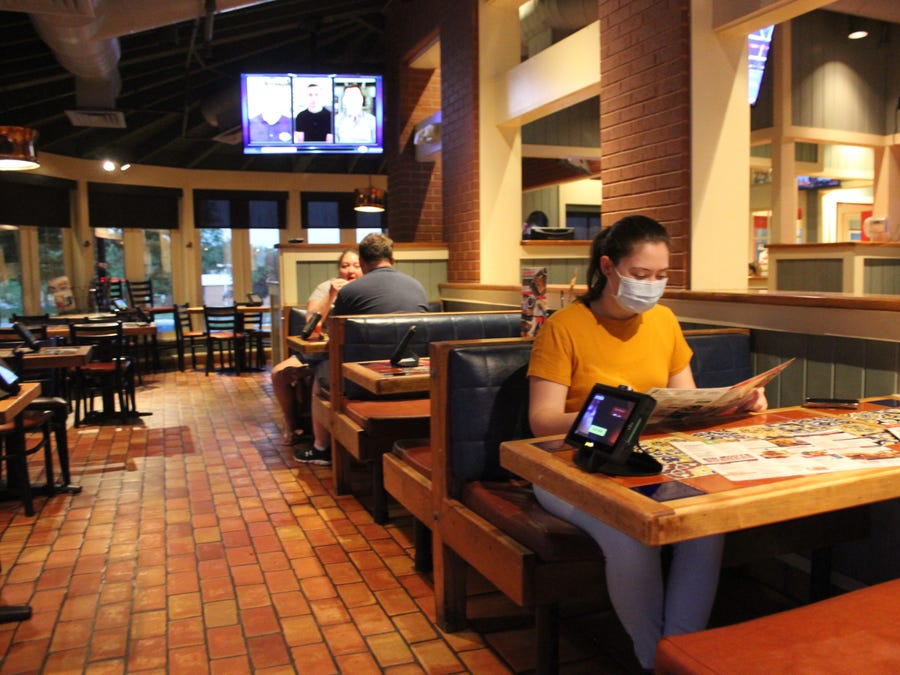
The interior of a Chili’s. Linh Ta/Business Insider
The Industry Will Look and Behave Differently Post-Covid
The U.S. Foodservice industry will come out of the Covid-19 pandemic looking somewhat different – if not better – than before. Innovations, such as mobile ordering, delivery to any location (even to a car), drone delivery and central/cloud kitchens have all been embraced at an accelerated pace.
As the saying goes, necessity is the mother of invention, and the structure of the foodservice supply chain is also at a tipping point when firms like DoorDash are poised to disrupt the decades-old (and contentious) broadline foodservice model. While some changes will be less-than-welcome (masks and limited seating capacity), others will create an easier way for the U.S. consumer to once again return to a dining occasion.
The rule of thumb is that 75% of U.S. Gross Domestic Product is composed of consumer spending. While establishments are still able to receive loans through the Payroll Protection Plan (PPP), more than 16 million Americans have lost the $600 supplement to state unemployment. What impact this will have on the economy is uncertain at this stage, but common sense tells us that losing the inflow of funds will reflect detrimentally on away-from-home spending.
Deals and Cheaper Dining Options Will Prevail During the Pandemic
In our latest survey, half of consumers (53%) confirm they will eat at restaurants less often to save money due to the pandemic. But like the collapse of 2008, when underemployment reached 17%, many consumers will be expecting deals (35%), select less-expensive options (33%) and order a less expensive item (31%) when dining out under the current conditions.
Which of the following are you likely to do in the coming months to save money due to COVID-19?
| Visit restaurants less often | 53% |
| Seek out restaurant deals/coupons | 35% |
| Select less expensive restaurants | 33% |
| Order less expensive item when purchasing from restaurants | 31% |
| Choose contact-free carry-out instead of delivery | 30% |
| Supplement take-out restaurant entrees with food/beverages from home | 29% |
| Actively avoid or seek low delivery fees | 25% |
| Take advantage of family meal deals | 23% |
| Take advantage of loyalty club deals | 21% |
Source: FSIP/Sandelman May 2020 Survey of QSR Customers
One of the anomalies of this Covid-19 situation is the rise in the equities market since its initial descent in March 2020.
Second quarter earnings from tech companies, a rise in personal consumption expenditures, a favorable ISM reading and an increase in private investment of 11.1% in June have led the Atlanta Fed (as of 8/7/2020) forecasting third-quarter GDP at 20.5% year-over-year (this on a record 32.9% contraction in the second quarter.)
Well-heeled Americans (those with household income of more than $100k) account for nearly half of all away-from-home expenditures, while they are only 15-20% of the total U.S. population. The Dow and S&P are teetering on record closes, which means the wealthier Americans’ habits will continue to favor eating out.
It seems clear, however, that without state and federal assistance, Americans relying on government stimulus will be financially strapped to pay rent, mortgage, utilities and other basic living expenses.
When economic indicators for this group – such as employment, disposable income, consumer confidence and wage growth – all improve, there is still only 26% who say they will return to “normal” restaurant habits immediately.
How soon will you return to normal restaurant habits once the stock market and economic indicators are healthy again?
| Immediately | 26% |
| After a couple of weeks | 16% |
| After a month | 23% |
| More than a month | 29% |
| Don’t know | 6% |
Source: FSIP/ Sandelman Consumer Survey
The Bottom Line
With so much uncertainty surrounding the pandemic and disagreement in Washington over stimulus packages, the path forward for food companies is to find those pockets of growth – like cloud kitchens, commissaries, senior living, meal kits and prepared foods – and to emphasize sales and marketing efforts in those key areas.
From a supply chain perspective, manufacturers will also benefit by reviewing procurement options to reduce reliance on powerful broadline distributors. There are several manufacturers “hedging” their bets and offering direct-to-consumer commerce through smaller platforms that can provide more flexibility than, say, Amazon Business.
We are in the process of conducting a study on the needs of operators and their openness to order directly from a food manufacturer. Our research so far has shown that 7 of 10 operators would prefer to order directly from a manufacturer if shipping, availability, pricing and ease-of-use were the same or better compared to current options.
Like the content? Please sign up to receive our communication.

Recent Comments